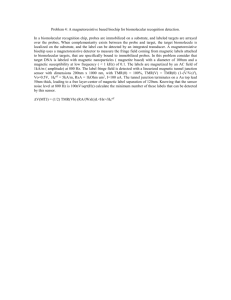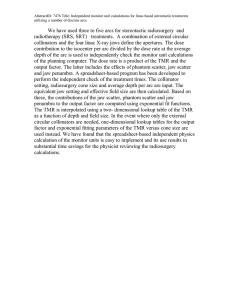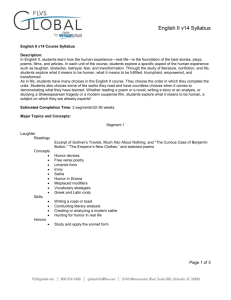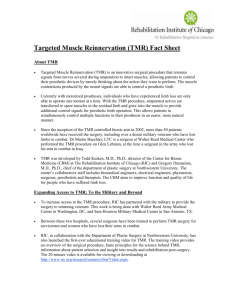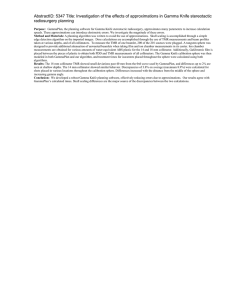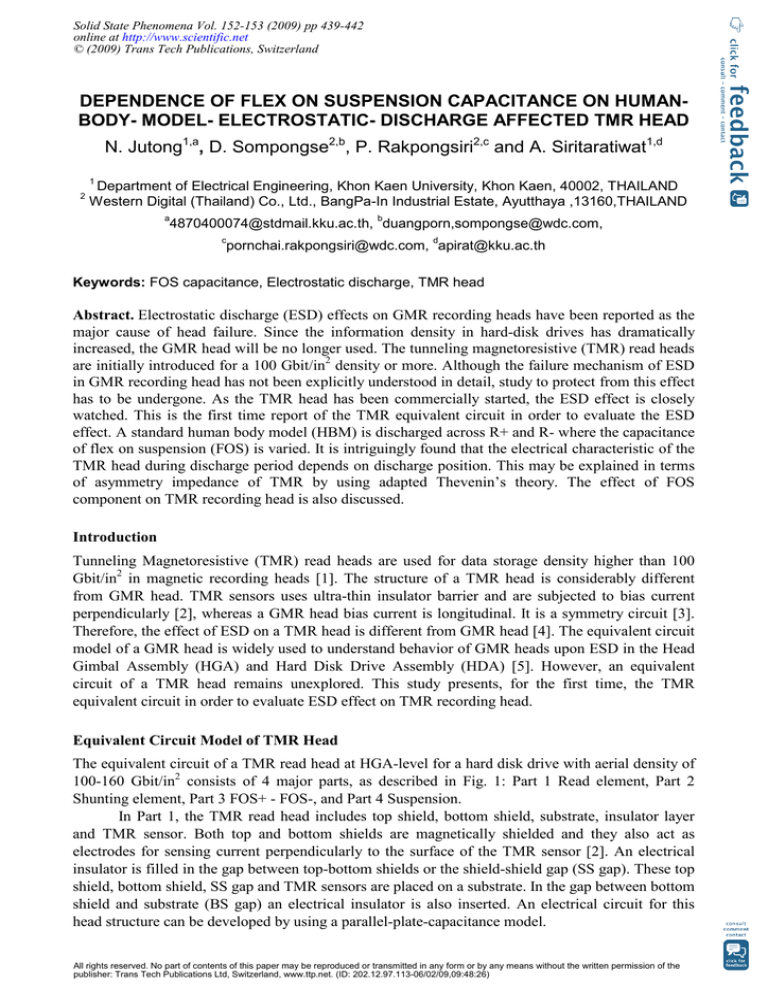
Solid State Phenomena Vol. 152-153 (2009) pp 439-442
online at http://www.scientific.net
© (2009) Trans Tech Publications, Switzerland
DEPENDENCE OF FLEX ON SUSPENSION CAPACITANCE ON HUMANBODY- MODEL- ELECTROSTATIC- DISCHARGE AFFECTED TMR HEAD
N. Jutong1,a, D. Sompongse2,b, P. Rakpongsiri2,c and A. Siritaratiwat1,d
1
2
Department of Electrical Engineering, Khon Kaen University, Khon Kaen, 40002, THAILAND
Western Digital (Thailand) Co., Ltd., BangPa-In Industrial Estate, Ayutthaya ,13160,THAILAND
a
4870400074@stdmail.kku.ac.th, bduangporn,sompongse@wdc.com,
c
pornchai.rakpongsiri@wdc.com, dapirat@kku.ac.th
Keywords: FOS capacitance, Electrostatic discharge, TMR head
Abstract. Electrostatic discharge (ESD) effects on GMR recording heads have been reported as the
major cause of head failure. Since the information density in hard-disk drives has dramatically
increased, the GMR head will be no longer used. The tunneling magnetoresistive (TMR) read heads
are initially introduced for a 100 Gbit/in2 density or more. Although the failure mechanism of ESD
in GMR recording head has not been explicitly understood in detail, study to protect from this effect
has to be undergone. As the TMR head has been commercially started, the ESD effect is closely
watched. This is the first time report of the TMR equivalent circuit in order to evaluate the ESD
effect. A standard human body model (HBM) is discharged across R+ and R- where the capacitance
of flex on suspension (FOS) is varied. It is intriguingly found that the electrical characteristic of the
TMR head during discharge period depends on discharge position. This may be explained in terms
of asymmetry impedance of TMR by using adapted Thevenin’s theory. The effect of FOS
component on TMR recording head is also discussed.
Introduction
Tunneling Magnetoresistive (TMR) read heads are used for data storage density higher than 100
Gbit/in2 in magnetic recording heads [1]. The structure of a TMR head is considerably different
from GMR head. TMR sensors uses ultra-thin insulator barrier and are subjected to bias current
perpendicularly [2], whereas a GMR head bias current is longitudinal. It is a symmetry circuit [3].
Therefore, the effect of ESD on a TMR head is different from GMR head [4]. The equivalent circuit
model of a GMR head is widely used to understand behavior of GMR heads upon ESD in the Head
Gimbal Assembly (HGA) and Hard Disk Drive Assembly (HDA) [5]. However, an equivalent
circuit of a TMR head remains unexplored. This study presents, for the first time, the TMR
equivalent circuit in order to evaluate ESD effect on TMR recording head.
Equivalent Circuit Model of TMR Head
The equivalent circuit of a TMR read head at HGA-level for a hard disk drive with aerial density of
100-160 Gbit/in2 consists of 4 major parts, as described in Fig. 1: Part 1 Read element, Part 2
Shunting element, Part 3 FOS+ - FOS-, and Part 4 Suspension.
In Part 1, the TMR read head includes top shield, bottom shield, substrate, insulator layer
and TMR sensor. Both top and bottom shields are magnetically shielded and they also act as
electrodes for sensing current perpendicularly to the surface of the TMR sensor [2]. An electrical
insulator is filled in the gap between top-bottom shields or the shield-shield gap (SS gap). These top
shield, bottom shield, SS gap and TMR sensors are placed on a substrate. In the gap between bottom
shield and substrate (BS gap) an electrical insulator is also inserted. An electrical circuit for this
head structure can be developed by using a parallel-plate-capacitance model.
All rights reserved. No part of contents of this paper may be reproduced or transmitted in any form or by any means without the written permission of the
publisher: Trans Tech Publications Ltd, Switzerland, www.ttp.net. (ID: 202.12.97.113-06/02/09,09:48:26)
440
Magnetism and Magnetic Materials
In Part 2, since the TMR sensor is currently considered as the most ESD sensitive device, the
technique of shunting resistance is employed to protect the head from ESD transient voltage.
A Flex on Suspension (FOS), in Part 3, is used for sensing current to read head in between
top and bottom shields. It can be modeled as a T-type-transmission-line with an RLC circuit. These
3 parts are then placed on a suspension, Part 4, by using insulating adhesive. Therefore, a parallelplate capacitance and a resistance can be considered as an electrical interconnection model between
substrate and suspension.
Part 3: FOS+
Part 1: Read Element
LFOS+
RFOS+
TOP Shield /Lead
Terminal -
Part 3: FOSRFOS-
TMR
LFOS-
RSS
CSS
CFOS+
Bottom Shield /Lead
R-
RBS
CFOS-
CBS
RShunt+
RShuntSubstrate
RSub-Sus
CSub-Sus
Suspension
Part 2: Shunting element
Part 4: Suspension.
Part 2: Shunting element
Fig. 1 Equivalent circuit of TMR recording head at HGA-level.
Experiment Result and Discussion
Because the current flow into a TMR sensor (ITMR) can not be directly measured in real magnetic
recording head. An equivalent circuit is used to study ESD effect in TMR heads .The standard
Human Body Model (HBM) is employed for ESD study discharging across R+ and R- terminals. An
ESD voltage (VESD) is varied until ITMR is larger than 1.25 mA. This amount of current is set by
manufacturing criteria for head degradation awareness.
Since FOS+ and FOS- are typically symmetric, a study of FOS capacitance effect on TMR
head at varied applied voltage is done.
3.25
3
Discharge across R+
2.75
Discharge across R-
2.5
ITMR (mA)
2.25
2
1.75
1.5
Degrading Line
1.25
1
0.75
0.5
0.25
0
0 0.5 1 1.5 2 2.5 3 3.5 4 4.5 5 5.5 6 6.5 7 7.5 8 8.5 9 9.5 10
Fig. 2 Dependence of VESD on discharge
terminal
VESD (Volt)
It is clearly seen from Fig. 2 that ITMR is doubly sensitive to VESD for R+ discharging rather
than that for R- discharging. The least magnitudes of VESD required to degrade TMR head are ~4 V
and ~8 V for R+ and R- discharging respectively. This result must be seriously taken into account
because it implies that the total impedance of TMR (ZTMR) when discharging across R- is higher
than that when discharging across R+. Since R+, R-, RBS and RSub-Sus are normally larger than 1,000
MΩ, they are assumed to be open circuits, as shown in Fig. 3. This TMR equivalent circuit is firstly
Solid State Phenomena Vol. 152-153
441
proposed in order to calculate Z ( j ) as well as to evaluate the relationship between I TMR ( j ) and
circuit elements by using an adapted Thevenin’s theory.
ZTMR
(a)
Z2
VCHMB
RHBM
VCFOS-
CFOS-
(b)
RTMR
Z1
LFOS-
LFOS+ V
CFOS+
CBS
RShunt-
RHBM
VCHMB
CSS
CHBM
RShunt+
CFOS+
CHBM
CSub-Sus
Fig. 3 TMR equivalent circuit for discharging across (a) R- and (b) R+.
The total impedances, ZTMR or Z ( j ) , for discharging across R+ and R- are approximately
given by
1
(1)
Z TMR
( j )
GTMR ( j )
1
(2)
ZTMR
( j )
GTMR ( j )
where GTMR
( j ) and GTMR
( j ) are total frequency-dependent TMR admittances when discharging
across R+ and R- respectively.
The VESD of 2 different discharging positions are now considered in the frequency domain.
Therefore, the calculation in Eq. 1 and Eq. 2 must be under conditions that
VESD
( j ) VCHBM (0) VCFOS ( j )
(3)
VESD
( j ) VCHBM (0) VCFOS ( j )
(4)
From Eq. 1 and Eq. 2, it must be kept in mind that the dependence of 1 / GTMR ( j ) on
frequency is in the same sense as that of ZTMR ( j ) and this relationship is shown in Fig. 4. It is
obviously confirmed by asymmetric TMR impedance that 1 / GTMR
( j ) > 1 / GTMR
( j ) and so,
ZTMR
( j ) > ZTMR
( j ) as mentioned.
The relationship between I TMR ( j ) and circuit elements can be calculated by multiplying
VESD by Eq. 1 and Eq. 2. Therefore I TMR ( j ) , for R+ and R- discharging, is inversely proportional
to GTMR
( j ) and GTMR
( j ) respectively. The GTMR
( j ) and GTMR
( j ) are more conveniently
analyzed by using Laplace’s transform technique than a direct frequency domain solving technique,
as given in Eq. 5 and Eq. 6.
2.5
x 10
-4
Fig. 4 Dependence of 1/ G( j ) for R+
and R- discharging.
G(j) mho
2
1.5
Discharge across R+
1
Discharge across R-
0.5
0 5
10
10
6
10
7
Frequency (Hz)
Frequency (Hz)
10
8
10
9
Magnetism and Magnetic Materials
3
2.75
3
2.75
2.5
2.25
2
2.5
2.25
I TMR (mA)
ITMR(mA)
442
1.75
1.5
1.25
1
0.75
0.5
2
1.75
1.5
1.25
1
0.75
0.5
Discharge across R+
0.25
0
0
1
Discharge across R-
2
3
Capacitance of CFOS- (pF)
4
Discharge across R+
0.25
0
5
(a)
0
1
Discharge across R-
2
3
Capacitance of CFOS+ (pF)
4
5
(b)
Fig. 5 Dependence of ITMR on (a) CFOS and (b) CFOS .
GTMR
( j ) Rshunt [( j Rshunt Cx 1)(( j )2 LFOS CFOS 1) ( j Rshunt CFOS )]
TMR
G
( j ) Rshunt [(1 j Rshunt CFOS ( j ) RFOS CFOS ]
where
2
(5)
(6)
Cx CBS // Csubsus
It is observed that G TMR ( j ) and G TMR ( j ) depend on CFOS and CFOS respectively.
Thus, the dependences of ITMR on CFOS and CFOS , as discharging R+ and R-, are shown in Fig. 5. It
is seen from Fig. 5 (a) when CFOS- increases that ITMR proportionally increases with CFOS- for R+
discharging but decreases for R- discharging. Intriguingly, ITMR exhibits the opposite when CFOS
increases, as shown in Fig. 5 (b). From this result, it is found that TMR head is dependent on both
FOS capacitance and ESD discharging position. This is evidently attributed to an asymmetric circuit
for the TMR head. Therefore, current conventional ESD detections in GMR head are definitely
unable to serve in TMR head manufacturing and methodology for ESD capturing will be
complicated to investigate.
Summary
It is initially found that impedance of TMR recording head is asymmetric by using information of
current manufactured TMR heads, It is undoubtedly shown that degradation of TMR head depends
on ESD discharging position (R+ / R-) and FOS capacitance ( CFOS / CFOS ). The equivalent circuit
of an asymmetric TMR head is also proposed for the first time. From this result, it is noticed that
present ESD detection in manufacturing is no longer in sufficient and a novel complex measurement
has to be further invented for detecting ESD in TMR recording heads.
Acknowledgement
This research is funded by the I/U CRC in HDD Components, Khon Kaen University, and the
National Electronics and Computer Technology Center (NECTEC) under the National Sciences and
Technology Development Agency (NSTDA), Thailand, Grant No. CPN-HR-03-10-50 D. Authors
would like to dedicate this work to staff of Western Digital (BangPa-In), Thailand, for their
provision of samples, facilities and technical discussion.
References
[1] S. Mao et al: IEEE Trans. Magn. Vol. 40 (2004), p. 307.
[2] K. Inage, US Patent 7,102,859 B2. (2006)
[3] A. Siritaratiwat et al: J.Magn.Mag.Mater. Vol. 272-276 (2004), p.2307.
[4] F. Liu et al: IEEE Trans. Magn. Vol. 42 (2006), p.2447
[5] Al Wallash: J. Micro Relia. Vol. 45 (2005), p. 305
Solid State Phenomena Vol. 152-153
Magnetism and Magnetic Materials
doi:10.4028/3-908454-13-1
Dependence of Flex on Suspension Capacitance on Human-Body-ModelElectrostatic-Discharge Affected TMR Head
doi:10.4028/3-908454-13-1.439
443


